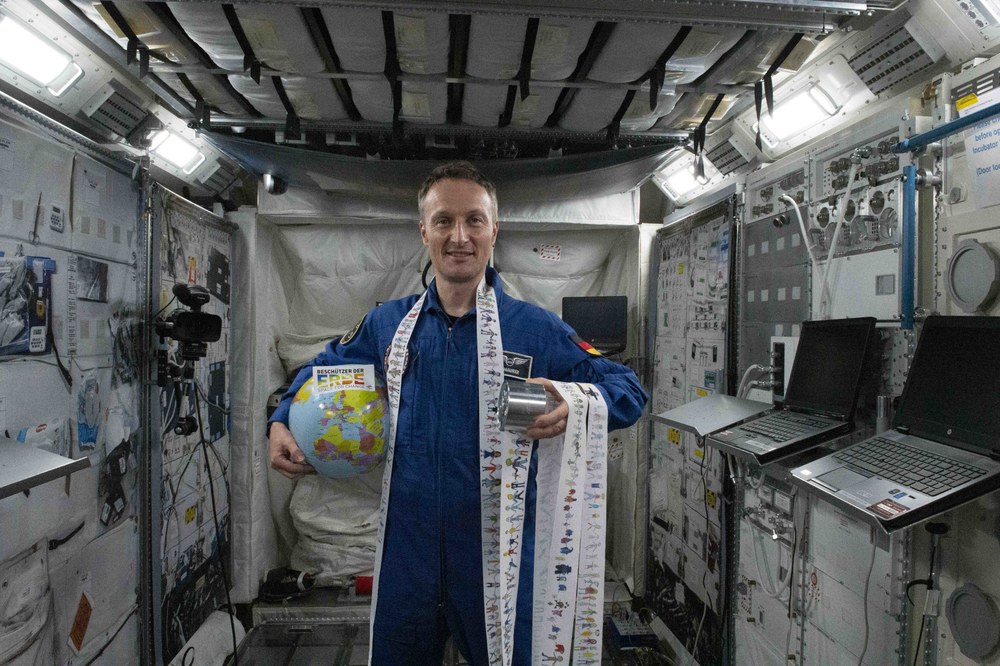Brochure: Cosmic Kiss (2021)
Comprehensive brochure on the first space mission of German ESA astronaut Matthias Maurer.


At the end of October 2021, the German ESA astronaut Matthias Maurer, together with the NASA astronauts Raja Chari, Thomas H. Marshburn and Kayla Barron, are expected to launch to the International Space Station (ISS) on board a Dragon space capsule from the US company SpaceX. Maurer will spend approximately six months in microgravity and return to Earth in April 2022. This will be the first space flight for the 51-year-old, who has been part of the ESA astronaut corps since July 2015 and has been preparing for his first space mission since successfully completing his basic astronaut training. The preparations have included training sessions at ESA's European Astronaut Centre (EAC) in Cologne, at NASA's Johnson Space Center in Houston, in the SpaceX Crew Dragon simulator in California and with the other ISS partners in Russia, Japan and Canada.
Maurer was born in Sankt Wendel in Saarland and has a doctorate degree in materials science. "I am fascinated by technology, science and cooperation in international teams, and that is exactly what my work will involve during the six months in space. I will take part in more than 100 experiments and hope that the findings from them will contribute to progress for our everyday life in space, but also here on Earth."
"A space mission is not easy," he says a few weeks before the launch, and continues: "A lot of my mental strength comes from the enthusiasm for what lies ahead of me now. A lifelong dream will soon come true – with a fantastic team that I can depend on at all times."
As a trained materials scientist, he is particularly looking forward to the experiments with new materials, which: "We will hopefully find in everyday life on Earth in a few years' time." Many things will be unique: "It starts with the exhilarating ride atop a rocket that accelerates me to over 28,000 kilometres per hour in less than 10 minutes. Arriving at the space station and making my first orbit in just 90 minutes, I will take in the beauty of Earth from our window in space, the Cupola. An extra-vehicular activity will hopefully take place and also be a highlight."
The German Aerospace Center (Deutsches Zentrum für Luft- und Raumfahrt; DLR) is involved in the mission in many ways. The German Space Agency at DLR, based in Bonn, is responsible for selecting and coordinating the experiments and contributions from German universities and colleges as well as from industry. DLR scientists are also conducting their own experiments. ESA's Columbus Control Centre, located at DLR's German Space Operations Center in Oberpfaffenhofen, is responsible for planning and conducting the experiments that take place in the European Columbus module on the ISS. From here, the data from the experiments are sent to the national user control centres and from there on to the scientists and the participating partners from industry. Thirty-six Cosmic Kiss mission experiments originate in Germany. They include fundamental research as well as application-oriented science and technology tests from the fields of life and materials sciences, physics, biology, medicine, artificial intelligence and Earth observation. In addition, Matthias Maurer's agenda includes an extensive education and outreach programme.
"Germany is the largest contributor to ESA's exploration framework programme. We are also the most prominent user of the ISS and create outstanding overall conditions for top scientists and German space industry to perform innovative research and experiments at the limits of what is possible. The ISS offers unique opportunities to conduct research for the benefit of people on Earth. In Matthias Maurer, we have an excellent scientist and an outstanding ambassador for international cooperation," emphasises Walther Pelzer, Member of the DLR Executive Board and Head of the German Space Agency at DLR, which is responsible for German's dealings with ESA on behalf of the Federal Government. "We wish Matthias Maurer all the best for Cosmic Kiss and look forward to seeing the results of his work. After all, spaceflight is a driver of innovation, offers considerable possibilities for commercialisation, highly exciting jobs and, for me, is an indispensable investment in our future."
Matthias Maurer's mission is called 'Cosmic Kiss'. The name is a kind of declaration of love for outer space, for the space station as a link between humanity and the cosmos, and for what people do there now and in the future. At the same time, it stands for the value of exploring space in partnership and for treating our home planet with respect and in a sustainable manner. The centre of the mission logo therefore features the ISS, which is connected to Earth and the Moon via a human heartbeat. The heartbeat is meant to symbolise the passion and curiosity that drives people to explore space, as well as the life science experiments that the space station makes possible. For the logo, Maurer was inspired by the Nebra Sky Disc (the oldest known depiction of the night sky) and the data carriers of the Pioneer and Voyager spacecraft (with the collected knowledge about humankind). They represent humanity's fascination with space and the desire to learn more about the origin of life, the Universe and our place in it. The emblem also includes various cosmic elements such as Earth, the Moon, the Pleiades (Seven Sisters) asterism and Mars.
Maurer is one of seven currently active ESA astronauts. The Moon and Mars have a special significance for him. Before the start of mission training in April 2020, he was Project Manager for the development of ESA's future lunar simulation facility, Luna, a joint project by ESA and DLR in Cologne. He has also participated in several geological field exercises related to future lunar exploration. In 2016, he was part of the crew of NASA's NEEMO 21 analogue mission, for which he spent a total of 16 days underwater testing exploration strategies and tools for future missions to the Red Planet.
